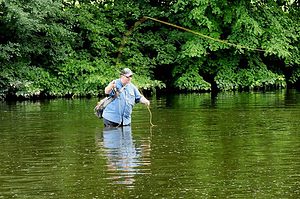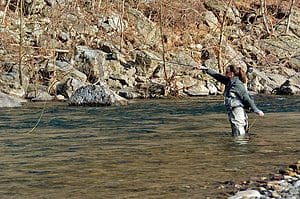Disclosure: Some posts contain affiliate links, which earn us a commission if you make a purchase through them. Positive Fishing © participates in various affiliate networks including the Amazon Services LLC Associates Program.
Great anglers can separate themselves from good anglers once their fly hits the water. Good anglers can choose the right gear, the right location, and even the correct casting point, but the technical work that happens once the fly hits the water is what makes the difference.
Mending, hook setting, and stripping methods take time and effort to learn, but the more you practice, the better you’ll find yourself.
It has taken me the better part of a decade of continuous mistakes to figure out what works and what doesn’t. It’s difficult to truly master fly fishing, and it takes patience and lots of time. The sport always throws something our way, making us evaluate and change how we approach fishing.
In this article, I will cover the three key factors which impact your chances of catching more fish:
- What is mending, and how do I do it?
- How do I properly set the hook?
- How do I retrieve or strip my line?
What Is Mending, And How Do I Do it?
If you ever take an introduction to fly fishing class as I did, you’ll hear the term “mending” thrown around all over the place. I never really understood the definition of fly fishing until I made my way out onto the water with someone who was far more skilled than me.
The literal definition of the word “mend” isn’t overly different from the fly fishing definition. In both definitions, you’re fixing something. In fly fishing, a mend will fix the position of your line to ensure that the fly is presented most accurately.
You’re fishing with insect imitations. These insects are living and have the capability of moving. Not only does mending provide some movement for the fly, but it also ensures that they’re naturally drifting across the water surface.
Most insects are at the mercy of the water, so they can’t control all of their movements. This is called a “dead drift”. Anglers who fish smaller nymphs, streamers, and dry flies should strive to accomplish this with their flies.
To accomplish it, you want to let your fly lead the way. As a result, you have to prevent your line from “taking charge.”
We’ll learn how to do this in the following sections.
How To Mend in Fast Water
Depending on where you’re fishing, you’ll likely find yourself fishing in fairly fast water. You’ll find that as soon as you cast your line in this fast-moving water, your fly tears downstream or downriver, and it’s out of the strike zone as soon as you can blink.
Don’t get discouraged when this happens. The first thing you will want to do is get as close to the “fishy” sections of the river as possible. Obviously, don’t stand in the fishy areas, but closer proximity will make your life easier because you won’t have as much line in the water.
A short cast upstream above the fishy section will give your fly time to get to where it needs to go. You must be prepared to mend as soon as your fly line hits the water. A good mend in fast water requires three things:
- First, immediately have the fly line in your hand when it hits the water.
- Second, start immediately stripping in slack because the fly will be close to you, and you don’t want an excessive amount of fly line in the water creating drag.
- Third, get ready to flip your wrist one way or the other depending on your fly line.
Since you want your fly and leader to lead the charge downriver, a great signal to mend is if you see your fly line forming a big loop below the fly. If you see the loop leading downstream, pinch the fly line to your rod, strip in a bit of slack, and turn over your wrist so that it’s faced fully down. If you do this fast enough, you’ll see that loop lift up and out of the water and go above instead of below your fly. The motion is similar to you making a small cast.
This action needs to happen fairly quickly. In fast water, you don’t have much time to work with. Often, you’ll have to make multiple mends in one drift, especially in fast water.
How To Mend in Slow Water
If you’re new to mending, I would suggest learning how to do it while fishing in slow water. You have more time to make decisions and can truly learn how water moves. Learning how water flows is a skill that’s imperative to fly fishing.
In slow water, a good mend follows the same principles as a fast water mend. Cast upstream, keep a hold of the fly line, and start stripping in slack as it drifts towards you. However, you have time to evaluate your fly line and leader in slow water. Depending on the size of your fly, it’ll naturally lead the way downstream. However, since the fly line is heavier than the leader, it’ll still lead the charge.
Be prepared to lift and turn over your wrist. This will get your fly line out of the way and put that loop back upstream where it belongs.
You can keep your rod tip a bit higher in slow water to keep more fly line out of the water. This method is called high sticking. It helps minimize any issues that low sticking causes. You’ll still follow your fly downstream with your rod tip.
Standing In Slow Water And Fishing In Fast Water
Anglers often find themselves standing in slow water but fishing in fast water. This situation can sometimes make an angler’s life easier but requires a bit more advanced movement.
As soon as you make your first cast up and across the river, you’ll likely see your fly take off downstream in the fast water. After a few seconds, you’ll see the fly swing across the water towards you.
This swing is caused by your fly line getting hung up in the slow water and pulling the fly back toward you. While swing fishing is a good idea, you don’t always want to do it this way.
To prevent that unnatural swing, you want to make your cast into the fast water and get as much fly line out of the water as possible.
Cast, strip in line, and lift your rod tip high. If you still have any excess fly line, you’ll likely have to mend downstream to help your fly line keep pace with your fly and leader. You want everything floating in as straight of a line as possible.
Standing In Fast Water And Fishing In Slow Water
Perhaps the most common situation anglers find is when they’re standing in fast water and fishing in slow water. This slow water can be a seam, an eddie, pool, or a cut bank. Remember, Slow water is most likely where the fish are!
When you cast into slow water but stand in fast water, you’ll find that your fly line is being swept downriver faster than your fly and leader.
You’ll have to mend upstream quite a few times to prevent this from happening. These should be smaller mends because you don’t want to pull your fly away from its drift position. Short flicks of your wrist are going to keep things in check.
Mending Tips & Tricks
- Plan Ahead – With mending, you want to anticipate the movements you must make. Planning with your mends is very important, so you’re already making them before the drag and unnatural drifts start happening!
- Do Not Wait – Mend as soon as the fly line touches down.
- Keep Rod Tip High – Lift your rod tip high during your mend.
- Be Positive – Be firm and quick with the mend.
- Starting – Always lower the rod tip at the beginning of the mend.
- Double Mend – If required, repeat the motion immediately after the first mend.
Lastly, always put the fly where you want it to be in the water; a poor cast can result in multiple mending and having less time to concentrate on watching the fly!
How Do I Properly Set the Hook on a Fly Rod?

Properly setting the hook when using a fly rod can take time to learn. For those anglers who came from spin fishing, it feels weird! Your instinctual movement isn’t wrong, but you need to understand strip and pinch sets.
There are two common methods for setting the hook in fly fishing:
What Is A Strip Set?
A strip set will do the trick if you’re targeting larger fish that need more force to help set the hook. However, before setting the hook, you must first prepare yourself.
First, To be ready to set the hook, you must have the fly line pinched to the cork handle of your fly rod with your pointer finger. This is going to help in the process of pinning the fish.
Secondly, you need to ensure you don’t have a ton of extra slack in the line before setting your hook. If you have slack and do a strip set, you might not even make the line tight when the fish takes it.
If you have these two things done, you’re ready. Now, once a fish takes your fly, don’t give up on the instinct to raise up the rod. This motion is still good. If it’s a larger fish, you’ll feel it pull the line pinned between your finger and the rod’s cork.
As you lift and pull the rod back, you want to use your non-casting hand to pull on the fly line quickly. Keep that line pinned between your finger and the cork handle of your rod, but that one strong pull will pin the fish and ensure it’s hooked. This method is also great if you have a bit too much slack out of your line!
What Is A Pinch Set?
Now, the easier hook set is the pinch set. The pinch set will only work if you don’t have any excess slack. The pinch is the fly line pinned between the rod’s cork and your pointer finger. If you’re fishing for trout, grayling, or other smaller fish, they won’t be able to yank the line out from your finger.
When you feel or see a fish hit your bait or fly, quickly lift the rod up and back like a traditional fishing rod. By keeping the line pinched, you’ll set the hook in the mouth of the fish and be ready to play the fish.
Note: While reading this article, there are a lot of words and terms relating to fishing that may be new to you; for easy reference, check out my link for a full list of phrases covering fly, saltwater, and freshwater fishing.
How Do I Retrieve Or Strip Line?

Line retrieval in fly fishing is a bit cumbersome at first, but you’ll quickly get the hang of it. Stripping/retrieval happens at various times throughout the fly fishing process.
Stripping/Retrieving A Small Fish
Once you’ve set the hook on the fish, it is time to get it to your net.
You may not even have to use your reel when stripping with a small fish on your line. You usually only need to use your non-casting hand. Keep the line pinned to the rod with your casting hand, and use that opposite hand to pull in the line. You’ll have a line pile by your feet, but doing this allows you not to have to reel in any slack before you begin fighting the fish on your reel.
Stripping/Retrieving A Large Fish
If you’ve hooked into a salmon or steelhead, you’ll likely want to fight it on your reel. To do this, you’ll have to keep the fish pinned with your casting hand while reeling in any excess slack line with your non-casting hand. Once all the slackline is retrieved, you can start fighting the fish like you would on a normal rod. However, make sure your drag is set correctly on your reel otherwise you are likely to lose the fish.
Stripping/Retrieving Your Flies
If you’re fishing streamers or even dry flies, you will be doing some stripping to imitate a baitfish or other form of prey. To do this, you can use a variety of methods.
Firstly, you should try standard 6 to 12 inch strips. This may be enough to entice the fish.
Secondly, sometimes, you may have to do short and hard 2 or 3 inch strips.
Thirdly, you may have to do larger 2 foot strips depending on the fish and where you’re fishing!
These fly retrieval methods are all trial and error. It’s up to you to find out through experience. You will quickly understand what you are doing right and/or wrong when you start catching more fish, losing fish, or missing bites.
Final Thoughts
Mending the line, setting the hook, and stripping the line are very important techniques for fly fishing. The only way to master these techniques is to get out on the water and practice!
I hope this article has given you the basics of how these processes work and when the right time to use them and do them correctly.
If you are new to fly fishing and want to brush up on your fly fishing basics, or if you feel it’s time to improve your fly casting ability, check out these two articles for more information.
- Wading Belt Essentials: Ensuring Safer Fishing - January 9, 2024
- Fishing For Catfish (Top Tips, Bait, & Gear To Catch The Big 3) - October 20, 2022
- Fishing Line Strength Vs. Diameter Chart: Why Is It Important? - October 12, 2022

